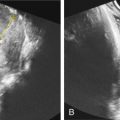Abstract
Meckel-Gruber syndrome is a severe ciliopathy first described in 1822. The worldwide incidence ranges from 1 : 1300 in Gujarati Indians to 1 : 140,000 in England. Twelve genetic mutations are associated with Meckel-Gruber syndrome (designated MKS1 through MKS12). In all cases, this disorder has shown autosomal recessive inheritance. The diagnosis of Meckel-Gruber syndrome is typically made by prenatal ultrasound examination in the first or second trimester. Meckel-Gruber syndrome is considered in an individual with a normal karyotype who has at least two of the three classic features: occipital encephalocele; large, polycystic kidneys; and postaxial polydactyly. Most affected individuals die in utero or mothers elect for termination of pregnancy. The postnatal mortality is 100% for individuals who survive to birth, with the longest survivor dying at 28 months. The major causes of death are pulmonary hypoplasia from oligohydramnios and liver disease.
Keywords
Meckel-Gruber syndrome, Meckel syndrome, Gruber syndrome, dysencephalia, splanchnocystica
Introduction
Meckel-Gruber syndrome, also known as Meckel syndrome or Gruber syndrome, is a severe ciliopathy. This developmental disorder was first described by Meckel in 1822 and later by Gruber in 1934. The minimum diagnostic criteria are controversial because the clinical manifestations of the syndrome are highly variable. The classic triad consists of a central nervous system malformation, typically occipital encephalocele; cystic kidneys; and polydactyly, most commonly postaxial. Fraser et al. reviewed affected siblings of probands, and proposed broadening the diagnostic criteria to include cystic kidney disease plus two or more frequently seen anomalies. Salonen et al. suggested including hepatic abnormalities in the triad instead of polydactyly.
Most affected individuals die in utero , or mothers elect for termination of pregnancy. The postnatal mortality is 100% for individuals who survive to birth, with the longest survivor dying at 28 months. The major causes of death are pulmonary hypoplasia from oligohydramnios and liver disease.
Twelve genetic mutations are associated with Meckel-Gruber syndrome (designated MKS1 through MKS12). There is variable expressivity of the condition within families. Genotype-phenotype interactions have been noted; for example, polydactyly and encephalocele are commonly identified in individuals with MKS1 mutations but are rarer in individuals with MKS3 mutations. In all cases, this disorder has shown autosomal recessive inheritance.
Disorder
Definition
Meckel-Gruber syndrome is considered in an individual with a normal karyotype who has at least two of the three classic features: occipital encephalocele ( Figs. 133.1 and 133.2 ); large, polycystic kidneys ( Fig. 133.3 ); and postaxial polydactyly ( Fig. 133.4 ).




Prevalence and Epidemiology
The prevalence of this disorder is not well established because of its early fatality and similarity to other diseases. The worldwide incidence ranges from 1 : 1300 in Gujarati Indians to 1 : 140,000 in England. Although the disease occurs in all ethnic groups, there appear to be certain ethnicities in which this disorder is more common. Barisic et al. in a recent population-based study reported an incidence of 1 : 38,615 births in Europe. The incidence in Finnish populations is approximately 1 : 9000. Meckel-Gruber syndrome also is more common in individuals of Belgian, Pakistan, Kuwait, and Israeli-Jewish descent. A higher prevalence has been reported when consanguinity is present. There is no predilection for gender because the male-to-female ratio is equivalent.
Etiology and Pathophysiology
Several genetic loci have been identified in individuals with Meckel-Gruber syndrome. The disorder is caused by dysfunction of primary cilia during embryogenesis. It is believed that heterozygous mutations in the associated genes cause disruption in mediation of ciliary development and epithelial morphogenesis, leading to the multitude of malformations identified in affected individuals.
Manifestations of Disease
Clinical Presentation
There are various malformations in Meckel-Gruber syndrome. At least two of the following three abnormalities must be identified: occipital encephalocele; large, polycystic kidneys; and postaxial polydactyly. Polycystic kidneys are present in almost all cases (95%–100%). Occipital encephalocele is present in 60%–80% and postaxial polydactyly in 55%–75% of patients. Hepatic malformations such as portal fibrosis and ductal proliferation are present in 38.5%–100% of cases. In addition, many other anomalies have been noted in affected individuals, including the following :
- •
other renal, bladder, and urinary tract malformations
- •
gastrointestinal disorders
- •
other central nervous system malformations
- •
Dandy-Walker malformation
- •
absent corpus callosum
- •
anencephaly
- •
- •
craniofacial defects
- •
oral clefts
- •
micrognathia
- •
microcephaly
- •
sloping forehead
- •
- •
ophthalmologic abnormalities
- •
hypotelorism or hypertelorism
- •
iris coloboma
- •
- •
endocrine defects
- •
absent pituitary
- •
hypoplastic thyroid
- •
absent or small adrenals
- •
- •
cardiovascular defects
- •
spleen abnormalities
- •
abnormal genitalia or gonads
- •
bowed long bones
- •
oligohydramnios
Imaging Technique and Findings
Ultrasound.
The diagnosis of Meckel-Gruber syndrome is typically made by prenatal ultrasound examination in the first or second trimester. In particular, occipital encephalocele may be identified at the end of the first trimester. Oligohydramnios is a common finding, especially in fetuses with polycystic kidneys, making visualization of fetal anatomy difficult.
Magnetic Resonance Imaging.
Magnetic resonance imaging may be complementary to ultrasound, especially when oligohydramnios limits the scanning resolution.








